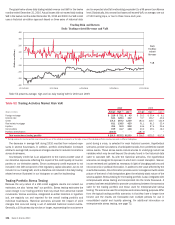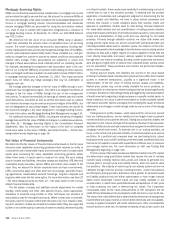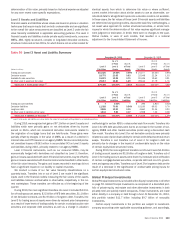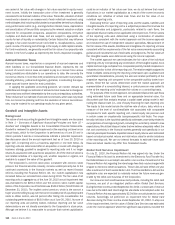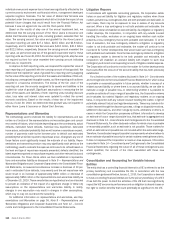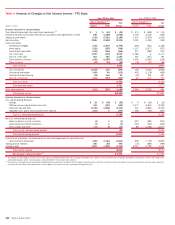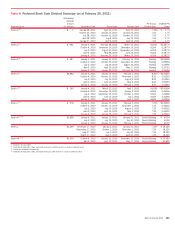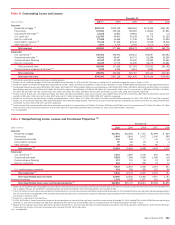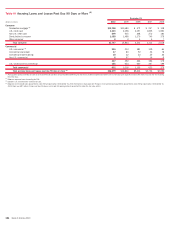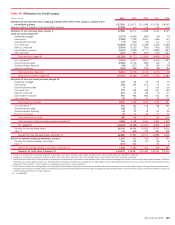Bank of America 2010 Annual Report Download - page 118
Download and view the complete annual report
Please find page 118 of the 2010 Bank of America annual report below. You can navigate through the pages in the report by either clicking on the pages listed below, or by using the keyword search tool below to find specific information within the annual report.individual revenue and expense items have been significantly affected by the
current economic environment and financial reform, management developed
separate long-term forecasts. The fair value of Global Card Services was
estimated under the income approach which did not include the impact of any
potential future changes that would result from the Financial Reform Act
because it was not signed into law until the third quarter 2010.
Based on the results of step one of the annual impairment test, we
determined that the carrying amount of the Home Loans & Insurance and
Global Card Services reporting units, including goodwill, exceeded their fair
value. The carrying amount, fair value and goodwill for the Home Loans &
Insurance reporting unit were $27.1 billion, $22.5 billion and $4.8 billion,
respectively, and for Global Card Services were $40.1 billion, $40.1 billion
and $22.3 billion, respectively. Because the carrying amount exceeded the
fair value, we performed step two of the goodwill impairment test for these
reporting units as of June 30, 2010. For all other reporting units, step two was
not required as their fair value exceeded their carrying amount indicating
there was no impairment.
In step two for both reporting units, we compared the implied fair value of
each reporting unit’s goodwill with the carrying amount of that goodwill. We
determined the implied fair value of goodwill for a reporting unit by assigning
the fair value of the reporting unit to all of the assets and liabilities of that unit,
including any unrecognized intangible assets, as if the reporting unit had been
acquired in a business combination. The excess of the fair value of the
reporting unit over the amounts assigned to its assets and liabilities is the
implied fair value of goodwill. Significant assumptions in measuring the fair
value of the assets and liabilities of both reporting units including discount
rates, loss rates and interest rates were updated to reflect the current
economic conditions. Based on the results of step two of the impairment
test as of June 30, 2010, we determined that goodwill was not impaired in
either Home Loans & Insurance or Global Card Services.
Representations and Warranties
The methodology used to estimate the liability for representations and war-
ranties is a function of the representations and warranties given and consid-
ers a variety of factors, which include depending upon the counterparty, actual
defaults, estimated future defaults, historical loss experience, estimated
home prices, estimated probability that we will receive a repurchase request,
number of payments made by the borrower prior to default and estimated
probability that we will be required to repurchase a loan. Changes to any one of
these factors could significantly impact the estimate of our liability. Repre-
sentations and warranties provision may vary significantly each period as the
methodology used to estimate the expense continues to be refined based on
the level and type of repurchase requests presented, defects identified, the
latest experience gained on repurchase requests and other relevant facts and
circumstances. For those claims where we have established a representa-
tions and warranties liability as discussed in Note 9 — Representations and
Warranties Obligations and Corporate Guarantees to the Consolidated Finan-
cial Statements, an assumed simultaneous increase or decrease of 10 per-
cent in estimated future defaults, loss severity and the net repurchase rate
would result in an increase of approximately $850 million or decrease of
approximately $950 million in the representations and warranties liability as
of December 31, 2010. These sensitivities are hypothetical and are intended
to provide an indication of the impact of a significant change in these key
assumptions on the representations and warranties liability. In reality,
changes in one assumption may result in changes in other assumptions,
which may or may not counteract the sensitivity.
For additional information on representations and warranties, see Rep-
resentations and Warranties on page 56, Note 9 – Representations and
Warranties Obligations and Corporate Guarantees and Note 14 – Commit-
ments and Contingencies to the Consolidated Financial Statements.
Litigation Reserve
In accordance with applicable accounting guidance, the Corporation estab-
lishes an accrued liability for litigation and regulatory matters when those
matters present loss contingencies that are both probable and estimable. In
such cases, there may be an exposure to loss in excess of any amounts
accrued. When a loss contingency is not both probable and estimable, the
Corporation does not establish an accrued liability. As a litigation or regulatory
matter develops, the Corporation, in conjunction with any outside counsel
handling the matter, evaluates on an ongoing basis whether such matter
presents a loss contingency that is both probable and estimable. If, at the
time of evaluation, the loss contingency related to a litigation or regulatory
matter is not both probable and estimable, the matter will continue to be
monitored for further developments that would make such loss contingency
both probable and estimable. Once the loss contingency related to a litigation
or regulatory matter is deemed to be both probable and estimable, the
Corporation will establish an accrued liability with respect to such loss
contingency and record a corresponding amount of litigation-related expense.
The Corporation will continue to monitor the matter for further developments
that could affect the amount of the accrued liability that has been previously
established.
For a limited number of the matters disclosed in Note 14 – Commitments
and Contingencies to the Consolidated Financial Statements for which a loss
is probable or reasonably possible in future periods, whether in excess of a
related accrued liability or where there is no accrued liability, we are able to
estimate a range of possible loss. In determining whether it is possible to
provide an estimate of loss or range of possible loss, the Corporation reviews
and evaluates its material litigation and regulatory matters on an ongoing
basis, in conjunction with any outside counsel handling the matter, in light of
potentially relevant factual and legal developments. These may include infor-
mation learned through the discovery process, rulings on dispositive motions,
settlement discussions, and other rulings by courts, arbitrators or others. In
cases in which the Corporation possesses sufficient information to develop
an estimate of loss or range of possible loss, that estimate is aggregated and
disclosed in Note 14 – Commitments and Contingencies to the Consolidated
Financial Statements. For other disclosed matters for which a loss is probable
or reasonably possible, such an estimate is not possible. Those matters for
which an estimate is not possible are not included within this estimated range.
Therefore, the estimated range of possible loss represents what we believe to
be an estimate of possible loss only for certain matters meeting these criteria.
It does not represent the Corporation’s maximum loss exposure. Information
is provided in Note 14 – Commitments and Contingencies to the Consolidated
Financial Statements regarding the nature of all of these contingencies and,
where specified, the amount of the claim associated with these loss
contingencies.
Consolidation and Accounting for Variable Interest
Entities
The entity that has a controlling financial interest in a VIE is referred to as the
primary beneficiary and consolidates the VIE. In accordance with the new
consolidation guidance effective January 1, 2010, the Corporation is deemed
to have a controlling financial interest and is the primary beneficiary of a VIE if
it has both the power to direct the activities of the VIE that most significantly
impact the VIE’s economic performance and an obligation to absorb losses or
the right to receive benefits that could potentially be significant to the VIE.
116 Bank of America 2010


